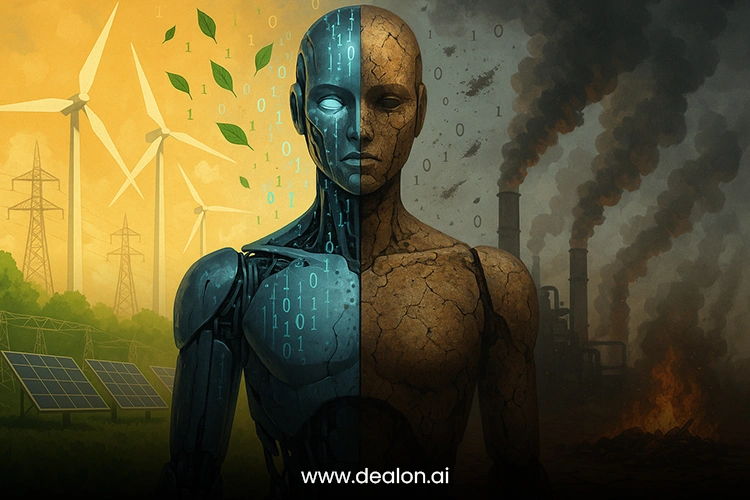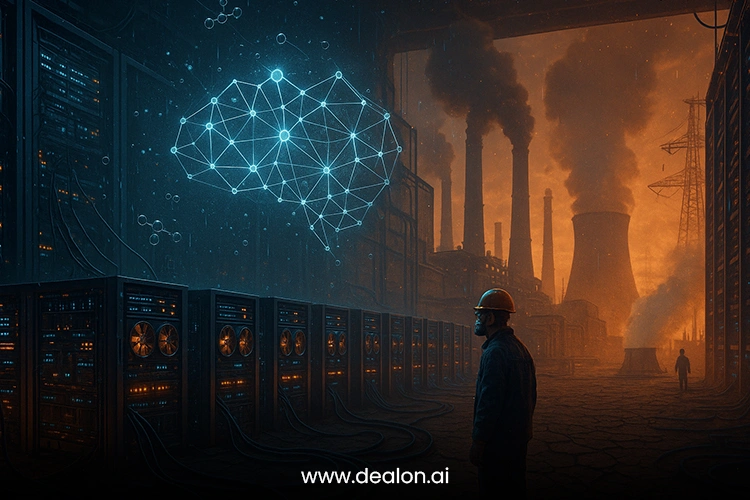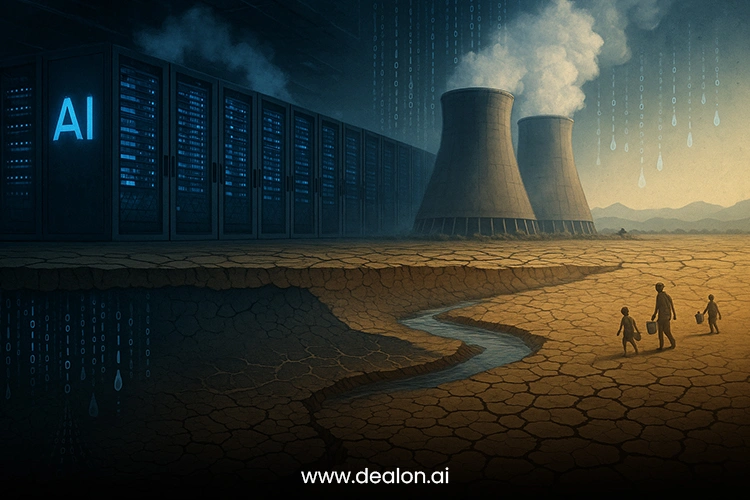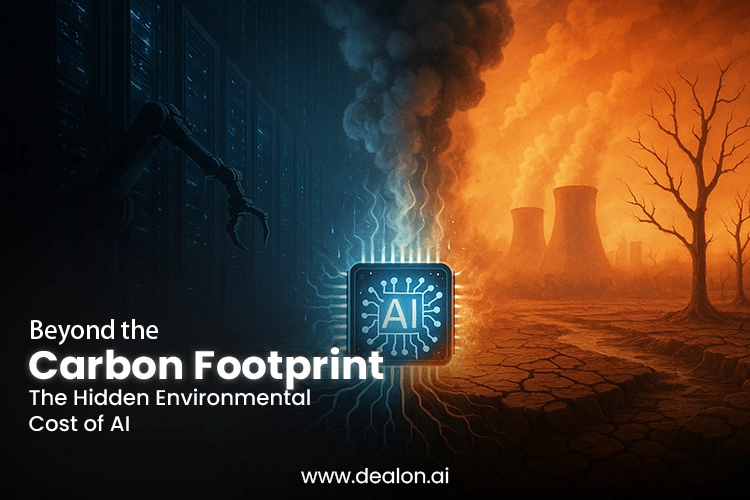Artificial Intelligence (AI) is viewed as an embodiment of human creativity—something that will change economies, speed up scientific advancements, and simplify how we live and work. AI is considered the driver of the “fourth industrial revolution,” but the costs of AI are hidden under the promise of advancement. Discussions mainly focus on the machine learning models and the training costs of AI. However, this misses the broader, more complex, and damaging ecological story.
The claimed negative environmental impact of AI is not confined to carbon. The claimed negative environmental impact of AI is not confined to carbon. The ecological consequences of data acquisition, production, operation, and data center disposal are immense. The excessive computational power required drives alarming freshwater consumption, which contributes to the carbon deficit, and freshwater consumption and cooling are in drought-stricken areas. The AI semiconductor and GPU production, the supercomputing and advanced AI applications, are made of super-pollutant materials that are of far greater magnitude and longer environmental half-lives.
The Unseen Contradictions. At the center of AI paradoxes lies the seemingly unfathomable optimism with which AI is heralded as a climate change mitigation tool. AI is remarkably celebrated for its ability to optimize renewable energy grids, enhance the design of the built environment to be more sustainable, and predict natural disasters. Yet, AI deployment quietly contributes to the carbon-intensive production, carbon-heavy logistics, and carbon-reliant operations of a business.
Alongside the unscathed deployment of AI technologies, the AI paradoxes converge upon never-ending climatic disasters. This produces unresolved contradictions that demand the simplistic rhetoric of carbon neutrality and prompts the need to assess AI in the context of a much wider lens of climate change- water scarcity, resource depletion, toxic waste, and e-waste. Achieving carbon neutrality will not suffice.
With the relentless AI revolution, the crass question has morphed from whether to implement AI to how to implement it sustainably and responsibly, given the lack of governance and the inertia of innovation in sustainable business practices.
Also Read: When AI is the Artist: The Legal and Ethical Wild West of AI-Generated Art
The Environmental Impact of Training AI

Large-scale AI training does come with exorbitant energy and carbon costs. Unlike traditional software, deep learning applications require powerful computing and sophisticated resources. Modern AI consists of many interconnected deep learning networks, each with billions of parameters, and multiple GPUs or tensor chips. Some of these AI models run continuously for weeks. One of these AI models can use and produce carbon emissions equivalent to what thousands of households use in an entire year.
But the environmental impact isn’t just electricity and carbon emissions. Ecological degradation occurs at every stage of the supply chain. The AI-em powering silicon chips comes deep in the earth’s mineral-rich and silicon-rich lands, where the ecosystem and water supplies are ruined with lithium, cobalt, and other pagan gem extraction. Lithium mining’s water-devouring aquifers and carbon-polluting mechanization and chemical processes aggravate the ecological costs. The costs do not end at assembly; carbon and fossil fuel-driven container shipping of GPUs globally distributes the AI’s carbon footprint. GPUs end up in vast halls of data centers and are used for deep learning applications.
Why This Matters

Data centers are the current manufacturing hubs of modern intelligence processing, and they are powered by electricity that is generated from fossil fuels, mainly coal and natural gas. While a few promises from corporations on complete withdrawal to renewable sources of electricity exist, the rate of decrease in coal consumption is too high for renewable consumption to be generated. This is the rate at which data centers power on the fans to disperse the excess heat, and thus, the electricity is dissipated in the provision of intel.
Compounding the problem is the production of hardware used for AI chips. Each new generation of advanced processors requires mining materials that are rare and hard to find, which escalates environmental destruction. The quest for swift, powerful processors perpetuates technological obsolescence, discarding the outdated hardware that contributes to electronic waste that increasingly pollutes soil and groundwater with heavy metals.
Cooling systems, on the other hand, quietly consume vast amounts of water. This hidden demand is especially problematic in drought-ridden areas where water is already contested. Unlike the limitlessness of the atmosphere, water and its scarcity are a zero-sum game. Aquifers and rivers that are depleted are practically irrecoverable for human use, taking centuries to renew.
Water Consumption: The Silent Sacrifice

Water consumption is the least acknowledged but most urgent environmental cost of AI. Running machine learning workloads generates large amounts of heat that, if unchecked, will damage servers. To solve this problem, data centers use evaporative cooling systems that draw on local freshwater supplies. The thousands of queries posed to a large language model might seem innocuous. Still, at a high scale, the millions of interactions that occur every day are the reason for massive amounts of water disappearing as vapor.
Such a phenomenon provokes an ethical dilemma. Artificial intelligence (AI) is marketed as a method to improve the management of water in agriculture, forecasting drought cycles, and aiding in climate adaptation. Yet, the technology amplifies the very problem of water scarcity by diverting critical resources from people and ecological systems. The inequity is even more pronounced because of geography. Many of the world’s most sophisticated data centers are located in dry regions of the world, where land is inexpensive and infrastructure is subsidized. These are also the regions of the world with vulnerable and land-encumbered populations who lack adequate access to freshwater resources.
The difference between water and carbon is that water cannot be replaced. Water can be foregone for long periods of time, and the systems that rely upon stable water cycles can collapse permanently. The profound and irreparable loss of water for the cooling of data centers illustrates an ignored component of machine learning and AI’s environmental impact, which cannot be accounted for by any carbon-based metric.
As the world integrates artificial intelligence into its systems faster than ever, it will be paramount to understand the hidden cost of water. These future solutions could be advanced methods of cooling, like liquid immersion, closed-loop water systems, and a more systematic analysis of data center placement. Not to defy the use of AI, but to plan and control it to ensure that the intelligence designed to aid humanity does not destroy the very essentials that it relies on.
Resource Extraction and E-Waste
The rapid advancement of AI technologies should not be seen independently of the massive physical infrastructure that supports its operation. Intertwined with every line of code executed by a neural network, there is a complex network of semiconductors, graphics processing units, and optical fibers that have been resource-intensive and require the extraction of delicate and limited natural resources.
The socio-ecological consequences of extracting, processing, and managing the supply chains of rare earth minerals are considerable and intricate. The supply chains of these minerals are primarily built in environmentally vulnerable areas, raising substantial concerns regarding loss of biodiversity and deep groundwater extraction. Exposed communities in these areas suffer from soil erosion and polluted air, and they endure the loss of agricultural resources.
The global supply chains that take raw ore and transform it into polished microchips are also carbon-intensive. Materials travel across several continents and undergo several energy-hungry refining and industrial processes, and are then incorporated into AI hardware. Each step in the supply chain increases the emission footprint and creates a gradient of environmental degradation that spills well beyond the data center. The problem is made worse by the rapid pace of obsolescence.
Each new generation of AI models requires more powerful chips and storage devices, quickly rendering the previous generation of hardware useless. This relentless cycle creates a growing problem of electronic waste. Discarded servers and processors, many of which contain heavy metals, are landfilled or informally deconstructed in the Global South, where they release poisonous wastes into the environment and expose human populations to dangerous levels of toxins.
The cycle involving extraction, consumption, and disposal is an ecological debt, an imbalance that no carbon offset scheme will ever come close to balancing. All deficits are financially imbalanced, and carbon offsets, such as tree planting or buying renewable credits, will never fully deforest mining landscapes, rejuvenate ruined and poisoned rivers, or eliminate backlogged, irreversible, and dangerous e-waste. The AI revolution is tethered to a material reality of extraction that will likely result in entrenched environmental degradation, despite the revolution being celebrated for unprecedented intellectual advances.
Invisible Emissions Beyond CO₂
Most discussions about the environmental impacts of artificial intelligence focus on the greenhouse gas carbon dioxide. However, the pollutants generated during the processing of semiconductors can be far more harmful. Certain gases (i.e., NF₃, NF₃) used in the microchip etching and cleaning processes have a global warming potential (GWP) thousands of times greater than CO₂. Even more worryingly, while their emissions volumes are small, their extraordinary lifetimes (hundreds to tens of thousands of years) in the atmosphere make them climate change silencers.
These gases are insidious climate change accelerators. Unlike carbon, NF₃ and SF₆ are pollutants in the true sense and are completely unreported in sustainability reports and literature. The semiconductor industry is particularly vulnerable to this unscalable reporting pressure, given the rapid increase in demand driven by the AI boom. Their atmospheric persistence means that minor manufacturing leakages turn into cumulatively long-lived climatically threatening hyper-warming. This is particularly true long after the chips have reached their end of life.
If businesses target only a narrow segment of environmental sustainability by defining it solely as “carbon neutral,” something dangerous can happen: they may develop a blind spot that exponentially increases risk. Comprehensive environmental sustainability must account for all pollutants, even the neglected ‘super pollutants.’ Addressing the challenges posed by super pollutants will entail international regulatory frameworks, transparency by AI-embedded technology firms, and even innovation in semiconductor fabrication.
The implications are clear: the environmental costs of artificial intelligence are much greater than CO₂ emissions. AI also contributes to the destruction of ecosystems, the generation of mountains of e-waste, and the emissions of invisible greenhouse gases with catastrophic impacts. Sustainability efforts, therefore, must be beyond symbolic activities and provide comprehensive stewardship to ensure the AI systems we create will not be developed to the destruction of our planet.
Towards Sustainable AI Practices
Currently, the socio-economic discourse concerning Artificial Intelligence and Sustainability is primarily concentrated on risk mitigation. Taking a step back from AI is not a reasonable starting point. The socio-economic opportunities AI affords, particularly in the climate change, educational, and health care sectors, are valuable. Henceforth, we must integrate necessary structural transformations in the design, development, and deployment frameworks governing Artificial Intelligence systems. AI systems must not be governed in a manner that their socio-economic benefits outweigh their environmental losses.
Implementing Green data centers is a logical starting point, which involves a straightforward first step of shifting to a more sustainable energy system. For example, moving to renewable energy sources allows for a disassociation of carbon-heavy infrastructures from AI computations. However, a simple energy substitution is not a long-term, complete solution.
Instead, new data center designs are aimed at revolutionary cooling systems, such as immersion cooling systems, where servers are placed in heat transfer fluids, or geothermal systems paired with networks that release heat and are used in urban heating networks. In addition to the reduction of water and energy, the wasted and dissipated heat is captured and indirectly used, as explained earlier in the concepts of circular design.
Equally, restructuring the obsession with scale in AI is of great importance. The pursuit of building bigger language and vision models has cultivated a culture of computational waste. Resource waste can be significantly mitigated in considerable amounts of AI systems as transfer learning, pruning, and distillation techniques are used in the construction of smaller optimized models that have resource achievement levels quite similar to larger models. Shifting the paradigm of resource utilization from brute force to AI, in the context of a more sophisticated approach of profitable design, is the target. In precise design, as well as context, a great deal can be achieved with far fewer resources.
These assessments, while powerful, remain underutilized. An actual full environmental audit of AI would need to capture not only the operational phase but also the mineral extraction, hardware manufacturing, international logistical transport, and disposal at the end-of-life phases. An absence of transparency means that policymakers, the private sector, and end-users cannot see the full ecological liabilities of AI systems. More problematically, the lack of such transparency means there is no disincentive to design for disassembly and closed-loop supply chains that capture e-waste for recycling, recover rare-molecule exhaust, and redesign obsolete hardware for modular reuse rather than permanent abandonment.
The missing value in these changes is policy and the mechanisms of accountability. Without governance, the risk of performative sustainability remains–in which sustainability looks good on paper but only means carbon accounting. Mandatory reporting on water use, rare-earth procurement, and super-pollutant gas emissions associated with semiconductor manufacture must be included in governance. AI infrastructure is unique in that it spans borders; as such, international collaboration on regulation is likely necessary. Finally, the lack of accountability at the corporate level becomes evident in the absence of environmental performance indicators specific to AI models and the lack of an energy-equivalent rating for such consumer electronics.
Conclusion: Beyond the Carbon Narrative
The environmental consequences of AI extend beyond what is assessed as simply a carbon footprint. While there are carbon emissions, the issue fundamentally relates to the unsustainable depletion of freshwater resources and the destabilization of ecosystems, while the emissions of climate super pollutants are indicative of the diverse and systemic, negative, and possibly permanent repercussions AI will have on the environment. If AI is to foster human flourishing while avoiding the degradation of the planet, the challenge will be to achieve sustainability across the AI ecosystem.
This involves a systemic reconfiguration of every stage of the AI lifecycle concerning the design for resource efficiency, the sustainability of the environmental governance framework, and the accountability of corporations and the public sector. The primary challenge with AI, then, should be to redefine the impact and not simply measure it. The resources of the new ecosystem should be managed to allow for intellectual provisioning and strategic withdrawal, with anticipatory and preservation-based resource philosophies. Only by moving beyond the simplistic carbon narrative will the positive and durable principles of planetary resilience be provoked in AI.

